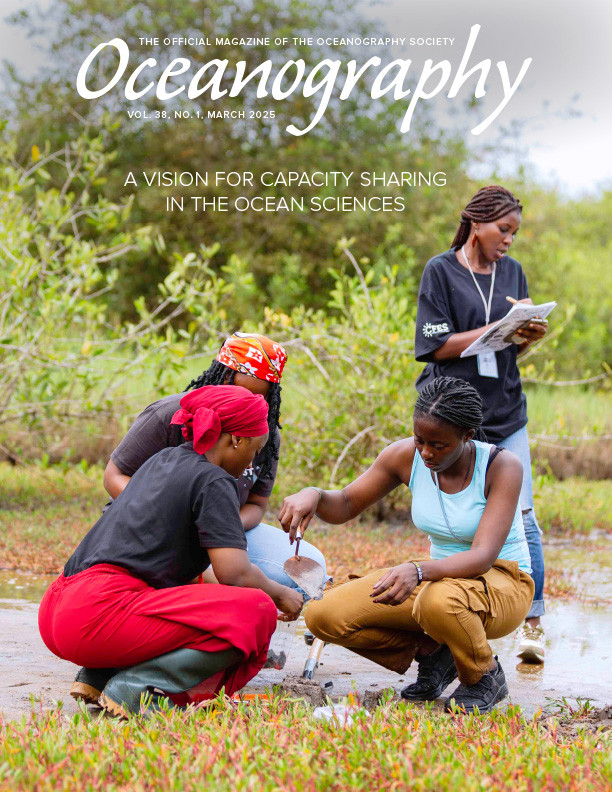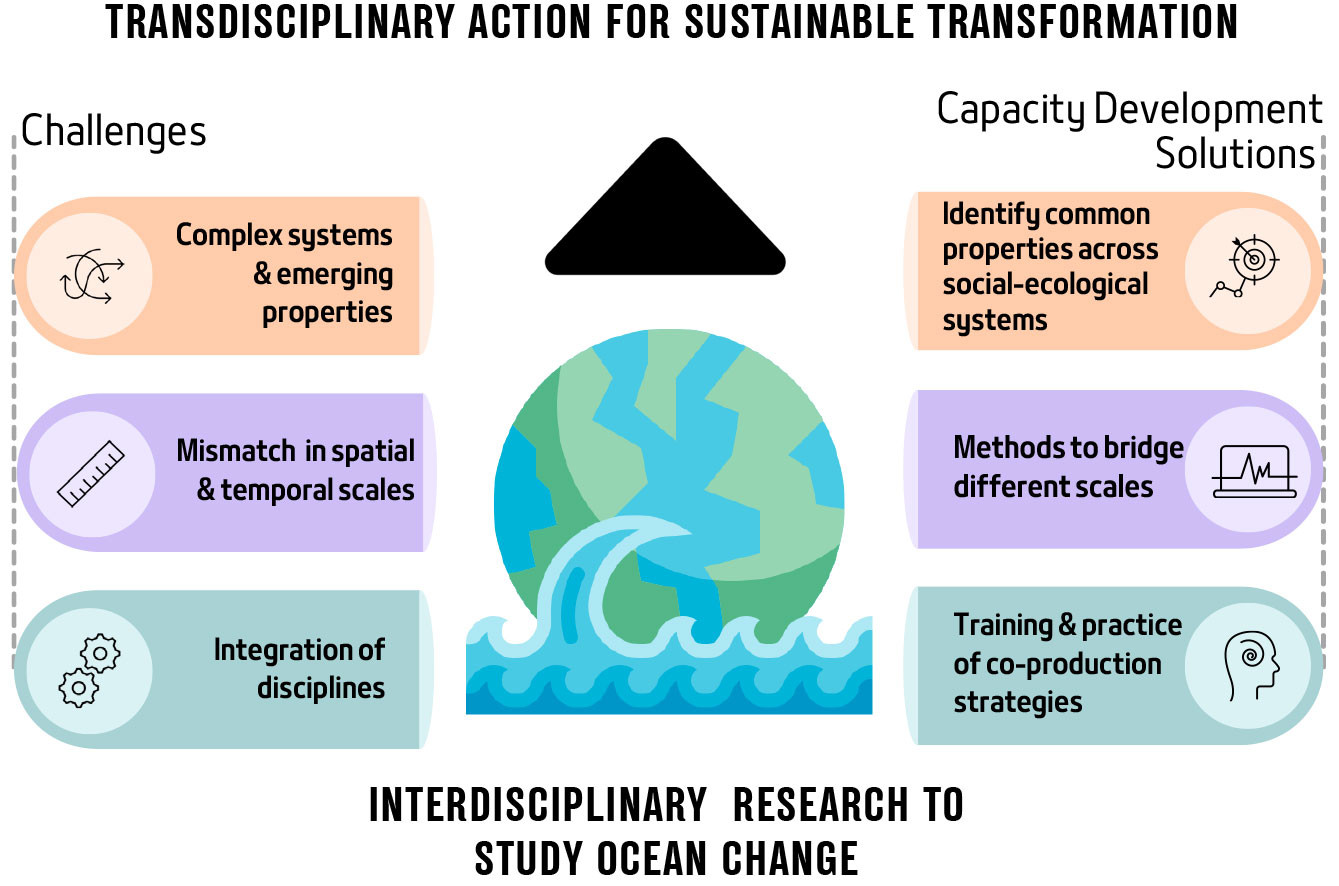Full Text
Addressing global challenges such as climate change requires large-scale collective actions, but such actions are hindered by the complexity and scale of the problem and the uncertainty in the long-term benefit of short-term actions (Jagers et al., 2019). In addition to climate change, socio-ecological systems face the cumulative pressures associated with resource needs, technology development, industrial expansion, and area conflicts. In marine systems, this has been called “the blue acceleration” (Jouffray et al., 2020) and is referred to as “socio-ecological pressures” in this paper. These socio-ecological pressures reduce our ability to reach the UN Sustainable Development Goals and meet the challenges of the UN Ocean Decade, and require integrating knowledge within a shared conceptual framework. For example, achieving sustainable growth must integrate ecological, socioeconomic, and governance perspectives on a larger scale by considering ecological impacts, ecosystem carrying capacities, economic trade-offs, social acceptability, and policy realities. This requires capacity development whereby actors unite to bridge disciplinary boundaries to meet challenges of complex systems.
We have gained considerable knowledge from monitoring, field and laboratory experiments, and modeling, and have developed national and international mitigation and adaptation plans. Yet, what is needed now is building and sharing techniques to expand and integrate work across disciplines and scales to generate meaningful solutions for entire societies. We introduce three case studies that combine and integrate insights from different disciplines that can serve as models for securing more sustainable socio-ecological systems.
Challenges and Examples of Capacity Building and Sharing for Transdisciplinary Action
Uniting natural and social science approaches to address ocean-change impacts on socio-ecological systems has major challenges falling into three classes: system complexity, spatial scales, and cultural differences among disciplines. These need to be recognized and solutions for each must be developed and shared to achieve sustainable transformation (Figure 1).
|
|
Case Study 1: Complex Systems and Emerging Properties
Ecological systems are dynamic networks of organisms interacting with one another and the environment. Environmental parameters determine which organisms can be present and how organisms influence each other through predation, facilitation, or competitive hierarchies. Further, ecosystems and societies are complex systems characterized by emergent properties resulting from interactions among system components that are not easily predictable from knowing the system’s structure. Examples include ecosystem services or socio-cultural organization around a shared resource. Socio-ecological pressures are already producing novel conditions, including combinations of drivers/stressors, species, and area-use conflicts not experienced previously. This complicates projections of impact both of natural systems and their interactions with human societies.
To address these challenges, underlying properties common across socio-ecological systems can be identified, suggesting that some emergent properties can be modeled. In addition, some studies show that transdisciplinary science in complex systems is possible where, for example, ecological impacts, societal perspectives, and industrial decision-making can be bridged (Ponce Oliva et al., 2019). In this example, a common goal among natural scientists, social scientists, and the aquaculture industry to adapt to ocean acidification led to new solutions for product development based on consumer preferences and willingness to pay. Such studies within and across economic sectors and stakeholder communities are examples of capacity building and provide insight into how we can adapt to existing pressures and improve sustainable ocean stewardship.
Case Study 2: Bridging Relevant Spatial and Temporal Scales
There is often a mismatch in the spatial or temporal scales over which environmental drivers act, the scales of scientific studies, and those scales pertinent to human societies and governance regimes (Dirnböck et al., 2013). This presents considerable challenges in selecting the scope of a study where practical requirements must balance the need for information that can be actionable and relevant. Efforts are needed to secure adequate methods to bridge different scales of study and use. Gladstone-Gallagher et al. (2019) showed that modeling and statistical integration of expert opinion and decision scenarios with empirical data collected at local scales can help address problems at the ecosystem scale. In another study, Beauchesne et al. (2020) used geospatial analysis of spatial patterns of multiple ecological and socio-economic drivers in the St. Lawrence estuarine system to identify areas of high overlap in stressor levels in the system to inform area-based management strategies. These examples demonstrate how existing methods can be used or adapted to bridge gaps of scale to arrive at solutions that are transdisciplinary and actionable.
Case Study 3: Integration of Diverse Perspectives
Socio-ecological system science integrates the human with the ecological dimension and acknowledges the complexity of human-nature interactions. Yet, achieving true transdisciplinarity requires that natural and social scientists agree on the nature of a problem and how to describe it, and build a common conceptual framework that synthesizes available knowledge. There exist, however, cultural issues across scientific fields that are historically distinct, with separate methods and terminologies. This is a well-known challenge that can be overcome through will, patience, and hard work so that participants can be more fluent in one anothers’ sciences. Moreover, an increasing number of studies advocate incorporating local knowledge, produced by the non-academic world, or cultural heritage when addressing sustainability challenges (Castagnino et al., 2023).
Capacity development and capacity sharing can play a key role in addressing these challenges. For example, the Integrated Marine Biosphere Research (IMBeR) program has been particularly successful in its integration of natural and social science through workshops/summer schools that bring together different disciplines. Such multiple “ways of knowing” can encourage co-production of strategies to address pressing problems in a transdisciplinary perspective. Further, dialogue among ecosystem modelers and diverse stakeholders in one innovative study led to improved understanding, new potential solutions, and greater understanding of and buy-in to the process (Fulton et al., 2015). But in many cases, improved awareness of the need for such approaches has not translated into more integrative scientific outcomes. When transdisciplinary studies are properly designed, they can integrate natural and social sciences to achieve relevant and transformative endpoints. A good example is ecosystem-based fisheries management (EBFM). A recent review of case studies in EBFM shows how capacity building through partnerships between science and stakeholders (industry, managers, user groups) can help cross the science-policy interface (Macher et al., 2021). This can take the form of, for example, co-development of new tools to solve a common problem or improved understanding of decision-making processes through participation in them. Such partnerships can only be achieved through investment in capacity development initiatives that facilitate dialogue and understanding between actors (Figure 1).
Lessons Learned
System complexity, disparate spatial scales of study and action, and cultural differences among disciplines hinder the ability to address ocean-change impacts on socio-ecological systems (Figure 1). Capacity building can resolve some of these issues, and we identified encouraging examples of possible pathways to achieving transformative action. Capacity building and sharing require a multifaceted approach that combines building relationships, aligning incentives, (co-)developing new methodologies, and creating a supportive environment for collaboration. By fostering a culture of openness and mutual benefit, organizations and communities can enhance their collective capacity to drive sustainable development. Acknowledgment of this need has been developed through education programs, but progressing further will require building upon successful model studies, such as those presented here.


